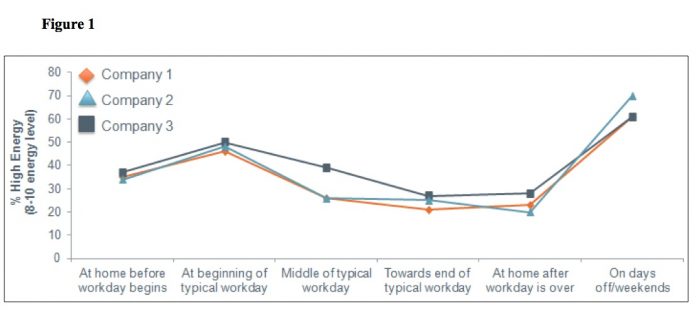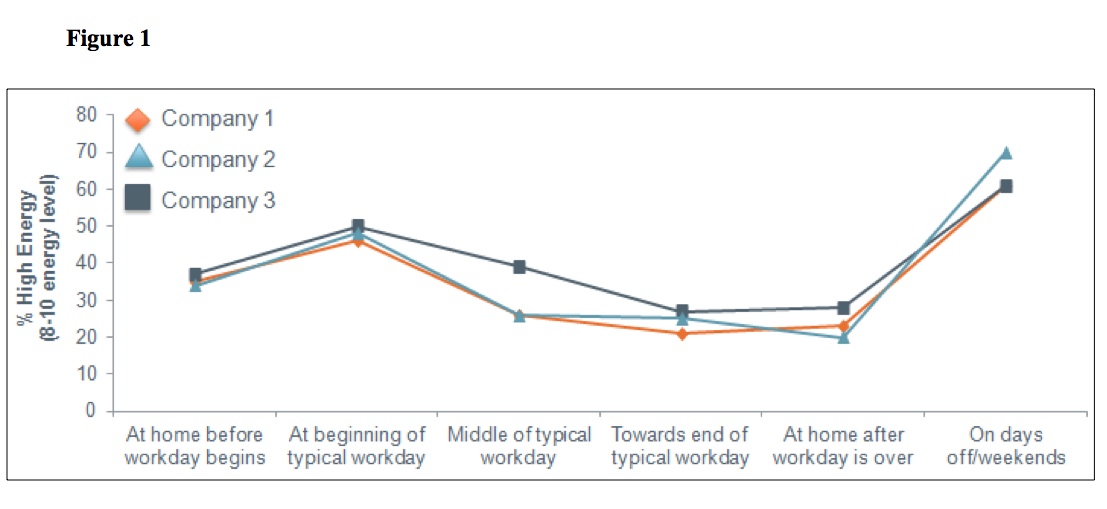
The evidence linking performance, productivity, well-being and our health is undeniable. But yet, the majority of us often put our health on the backburner. The No. 1 reason people give for not engaging in their health is lack of time (1). But is time really the problem?
Time remains one of the few things man cannot control. There is a resource we have that in many ways is even more valuable and that we have more control over: our energy. Time creates opportunity, but it is the energy we put into time that brings action and impact. Ultimately, energy is what gives time its real worth.
In a recent study (1), 27 percent of employees stated they are not at all satisfied with their energy levels, and 46 percent stated they are only somewhat satisfied. Almost all surveyed (93 percent) stated they are interested in improving their energy levels throughout their day. These results clearly underscore the notion that energy is in high demand. So is there a way we can make more of it?
The Power of Energy Microbursts
In more than 30 years of studying elite athletes and world-class performers in business, medicine, and the military, we have learned that energy is a key driver of high performance and engagement (2). However, in studying employee energy levels, we uncovered a consistent pattern: People start their day with relatively high energy that gradually declines throughout the day (3).

Microburst is a word that was coined related to energy management, in which micro represents a small energy investment and burst characterizes the disproportionately bigger energy return. It is a small (short in duration), intentional activity that results in a disproportionate, higher return.
In fact, a single “dose” of activity can make a significant difference. Our study showed that performing a single microburst of physical activity when feeling tired (i.e., spending five minutes walking up and down stairs, at an easy pace) can triple energy levels (4). Surprisingly, an hour later, the effect lingered, leaving people still feeling double the amount of energy as they did before the activity (4).
Workplace activities such as meetings and conferences appear to be particularly energy draining. However, recovery activities (e.g., rest or stretching), 10 minutes or less of physical activity, or even having a conversation with a loved one are especially energizing. This observation raises an important point: Microbursts do not have to be solely physical. Mental, emotional, or spiritual activities also can have a strong impact on energy levels (2).
Interestingly, the average energy rating for those we studied who reported having a cup of coffee was less than that of performing a microburst of recovery or short physical activity. A microburst of activity within the workplace easily could be substituted for an afternoon or morning coffee, resulting in potentially equal or even better perceived energy.
Evidence for the Microburst Effect
There has been growing scientific evidence regarding the benefits of microbursts—particularly those of physical activity. A short bout of physical activity (10 minutes of exercise) has been reported to result in improvements in vigor, fatigue, and total mood (5). In fact, compared to longer bouts of physical activity, short bouts seem to have additive effects, and are just as strongly associated with several biologic health outcomes (6), including aerobic fitness (7,8,9) and weight loss (7).
This suggests that we may be able to enhance our health by engaging in an active lifestyle, despite the time constraints most often cited as a barrier, or the perception of the need for high-intensity activities. In fact, if you spend all day sitting, it has been shown that even performing an hour of physical exercise cannot compensate for the negative effects of being inactive on certain health risks (10).
Putting the Microburst into Practice at Work
It is possible to improve the energy rhythm curve of Figure 1 by using an intervention consisting of many microbursts throughout the day. In a study we named Organizations in MOTION (3), we asked employees to insert a microburst approximately every hour into their workday over a 90-day period. These were not advocated as breaks, but rather, employees were asked to do things such as stand up at their desk and stretch, take five minutes to catch up on a project with a colleague while walking the stairs, partake in emotional or mental recovery, etc., as they worked.
At the end of 90 days, we found that their energy rhythm curves did, in fact, change. Not only did their energy increase during the day (particularly in the afternoon), but even after they left work, participants reported having more energy at home. Remarkably, participants also reported increased engagement, focus, performance, and intrinsic motivation during their workday (3).
End Word
The concepts of health and engagement don’t need to be overwhelming and time consuming. It is possible for business leaders to positively affect energy levels, harness energy as a strategic advantage, and ultimately help improve performance. In the end, expanding people’s energy can enable them to feel more engaged—both at work and at home.
The power of microbursts is in their accessibility, versatility, and simplicity. Achieving energy through small changes can be very powerful. A microburst of a physical action (e.g., movement or eating a snack), an emotional shift (e.g., changing an impatient attitude to one of positivity and supportiveness), a mental thought change (e.g., going from a perception of a blur in time to one where you are in control of your time with some type of structure or habit you put in place) or spiritual (e.g., where you connect momentarily with something or someone that really matters to you) can be performed in almost any setting in a short amount of time. But to get there, we need to alter our thinking. We need to resist a linear, non-stop lifestyle and embrace one infused with microbursts of recovery. If we start performing microbursts throughout our day, over time, health and engagement simply will become a side effect.
References
(1) Move Beyond Traditional Participation & Engagement Strategies: Wellness & Prevention, Inc. Landmark Study, 2. Published by Wellness & Prevention, Inc., 2010.
(2) Loehr J & Groppel J. The Corporate Athlete Advantage: The Science of Deepening Engagement. Orlando, FL: Human Performance Institute; 2008.
(3) Groppel J & Alexander J. Becoming an Organization in MOTION: Investigating the Organizational Impact of Strategic Movement Throughout the Workday. Published by Wellness & Prevention, Inc., 2012.
(4) Nikolovski J & Groppel J. The Power of an Energy Microburst. Published by Wellness & Prevention, Inc., 2013.
(5) Hansen C, Stevens L, & Coast J (2001). Exercise Duration and Mood State: How Much Is Enough to Feel Better? Health Psychology; 20(4): 267-275.
(6) Loprinzi P & Cardinal B (2013). Association Between Biologic Outcomes and Objectively Measured Physical Activity Accumulated in ≥10-Minute Bouts and <10-Minute Bouts. American Journal of Health Promotion; 27(3): 143-151.
(7) Schmidt W, Biwer C, & Kalscheuer L (2001). Effects of Long Versus Short Bout Exercise on Fitness and Weight Loss in Overweight Females. Journal of the American College of Nutrition; 20(5): 494-501.
(8) Woolf-May K, Kearney E, Owen A, Jones D, Davison R, & Bird S (1999). The Efficacy of Accumulated Short Bouts Versus Single Daily Bouts of Brisk Walking in Improving Aerobic Fitness and Blood Lipid Profiles. Health Education Research; 14(6): 803-815.
(9) DeBusk R, Stenestrand U, Sheehan M, & Haskell W (1990). Training Effects of Long Versus Short Bouts of Exercise in Healthy Subjects. The American Journal of Cardiology; 15(65): 1010-1013.
(10) Duvivier B, Schaper N, Bremers M, van Crombrugge G, Menheere P, Kars M, & Savelberg H (2013). Minimal Intensity Physical Activity (Standing and Walking) of Longer Duration Improves Insulin Action and Plasma Lipids More than Shorter Periods of Moderate to Vigorous Exercise (Cycling) in Sedentary Subjects When Energy Expenditure is Comparable. PLoS One; 8(2): e55542.
Excerpt from white paper “The Power of an Energy Microburst” by Janet Nikolovski, Ph.D., and Jack Groppel, Ph.D. To read the full white paper, visit http://www.wellnessandpreventioninc.com/insights/white-papers
Janet Nikolovski, Ph.D., is associate director and Fellow, Science and Innovation, at Wellness & Prevention, Inc., a Johnson & Johnson company.
Jack Groppel, Ph.D., is co-founder, Human Performance Institute, Inc., and vice president, Applied Science and Performance Training, Wellness & Prevention, Inc.



